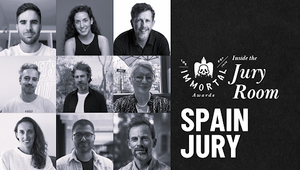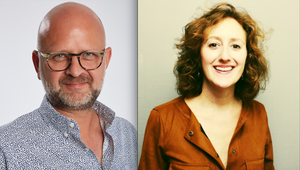
5 Minutes with… John Treacy

John Treacy spent his teen years drumming (although he’d admit not very well) in an acid jazz band. Devastatingly, it never really took off for him. But he did end up in the music industry trying to follow in the footsteps of his idols Peter Saville and Vaughan Oliver designing record covers. When the music industry failed to satisfy him as he hoped it would he drifted into advertising, becoming a creative, and soon a creative director, at Grey Direct and Joshua (Geometry), before taking up a senior position at AIS. He then became founding partner and ECD at Elvis, where he stayed for a whole decade.
Since 2013 he’s been plying his trade at Proximity London as executive creative director and in over five years he’s helped the agency garner heaps of awards, including a Gold Effectiveness Lion for The Economist and Agency of the Year in 2015.
LBB’s Alex Reeves caught up with John about all sorts of stuff.
LBB> In the sort of digitally focused work that Proximity does, what is the importance of craft, in your view?
John> Traditional craft skills (for all the fashions in the industry) are the one thing that, from a creative point of view, makes you different.
Ideas are everything, but if you’re working in the digital space, the attention to detail you’ve got to put into it to make them come to life is so much more complicated than a broadcast idea, so much richer, so much deeper. You’ve got to have all of those storytelling skills but you’ve got to take them to more dimensions. Which is why there are probably not as many brilliant examples of doing it. Only every so often you do see something genuinely brilliant.
But you don’t notice it. It’s like the old saying: “No one ever notices good typography.” You appreciate brilliant craft on an emotional level. You just get into it. If it's not right you very quickly know.
LBB> Executing a great digital idea must be quite different to manage, considering there’s the tech and the UX aspects to consider as well as the creative. How do you deal with that?
John> The interesting dynamic in agencies is usually in those three areas. It is a fine line sometimes to keep everything happy. UX have a very strong viewpoint on the world, but they don’t necessarily have the deep brand understanding; they understand the user. Technology becomes overpowering if it’s not made accessible. Then the creative people want to protect the integrity of their ideas.
So my job is inevitably the ringmaster trying to bring those three together so that it works. Marshalling that is how you manage those more extended, complicated teams, when to play people in and how to make that process work, make people still feel involved even when certain bits of the process aren’t necessarily their specialism. You have to be prepared to let go of an idea and give it to the next person, who’s going to be able to make you look better than you are.
LBB> What was your upbringing like and what were your priorities back then?
John> I grew up in Croydon. It’s a weird place to grow up because you’ve got one foot in London and one outside. I was always more one foot in. I was on the doorstep of the most amazing place to live in the world. It’s such a strong magnet. Everything I was interested in was on my doorstep if I wanted to find it. A lot of people growing up in Croydon choose to ignore that bit.
I was really into music as a teenager, in a way that a lot of teenagers are. It was a massive passion, still is. I was a terrible musician, but it was always around. I was also really into sport. I played a lot of football. I always had artistic stuff going on - making films, painting, whatever. As a kid I had a really broad set of influences and interests.
All these things inform each other. Sometimes in a small town people get sucked into one little subculture and stuck, because it’s comforting. I had lots of mates that were into graffiti for example and that was their thing. Their whole life became about that. But that has a limited lifespan for most people.
LBB> What sort of music did your band play?
John> It was when acid jazz was a big thing, so it was that kind of era. A lot of great bands come out of art colleges and we had all those dreams but we were shocking.
LBB> What else do you remember from art school?
John> Doing a foundation course was an interesting experience. I went into it thinking I was going to be an artist and after a couple of terms I swiftly realised that wasn’t going to be my life. I was lucky. I had a brilliant tutor called Lawrence Stevens who used to design a lot of artwork for people like the Eurythmics. He’d come in and show us the work he was doing at his studio. At that point I realised for the first time that I can marry these two interests. It looked like a lot of fun. So it crystallised in my head where I wanted to go from a design perspective.
I was only 19. Having someone show us the commercial reality of that world was brilliant because it gave me something to aim for. Music was such fertile territory. There’s such a great history, whether that’s Peter Saville and all the Factory Records stuff or Vaughan Oliver - at the time there was some amazing design around that was a big influence on me. It felt like a natural progression.
LBB> At what point did you start seeing yourself primarily as a designer?
John> When I came out of college, that was my thing. I did some time in record industry. This was the early to mid ‘90s. I did stuff on lots of bands like Terrorvision (for my sins), some stuff for The Cocteau Twins, some quite cool stuff. What I realised is the record industry doesn’t necessarily afford you a lot of creative freedom. There are few brilliant examples where that has happened but a lot of the time you’re handed a photo and told to put the artist’s name in the top right hand corner. My dream of it being like Factory Records wasn’t the reality. But it was a brilliant grounding in that world and a lot of fun.
I graduated in the middle of a huge recession as well. So I’d love to say I had some grand career plan but I made the leap into advertising as a calculated decision. Designing CD covers wasn’t really something I could sustain in London.
LBB> What were your thoughts on advertising at the time?
John> I was very aware of BBH, who were doing incredible stuff. What attracted me was the idea that you could make advertising as relevant, culturally, as music - which is what they were doing at the time. That’s when the light went on for me. I realised you could have massive influence and be hugely creative without having to compromise on your principles. The more I got into the industry, the more I realised there were so many more creative opportunities in the advertising world than in the music world. Which was weird. There’s more budget. The record companies, even at the time, were run on a shoestring.
LBB> So you really just drifted into advertising and somehow ended up at Grey?
John> It was a drift. But I immediately realised I’d made the right decision. I always had a very conceptual approach to design and as an art director that’s important, but I realised that I was actually much better at the problem-solving aspect of the job. I was more into the idea than being sat on a Mac for five days scanning bits of old fax paper and crafting something to the nth degree.
LBB> And eventually your career built to the point where you founded the agency Elvis. What did you learn in your career that shaped that?
John> Before Elvis I was working at an agency called AIS. At the time it was a start-up and I was the sixth or seventh employee. That made me realise how much I enjoy being in a start-up. I’d gone from Grey in a huge network and the energy was completely different. It was much more fun.
When I went to Elvis I was trying to take the spirit of what we’d had at AIS into that. Start-ups always have a bit of a point to prove. I think that’s what really appealed.
LBB> What were you mainly trying to achieve with the new agency?
John> Before we had a name for the agency our code name was Mantis Shrimp. It sounds ridiculous but the reason for it was that mantis shrimps have this enormous club that means they’re really agile but they can take on prey twice their size. That was our whole thing at Elvis. We needed to have the agility of a start-up with the delivery ability of a really big agency. We felt that a lot of agencies had got quite dull and we wanted to inject that energy back in but with a solid insight and delivery platform that most agencies didn’t have.
LBB> What have you been proud of recently?
John> The new Economist brand work - ‘Never Stop Questioning’. We’ve worked with The Economist for five years, won Cannes Gold for them, but they’re a news organisation; they’re about current affairs and being tactical and right on it to the minute. We’d been really successful with that work but they hadn’t invested in their brand for 10 years. So it was great to work with a client we knew really well, repositioning their entire brand.
The commercial had to work in the US and the UK, which was an interesting challenge because the magazine is perceived quite differently in different markets.
Our insight was based around curiosity and trying to produce some storytelling that wasn’t just talking about news events, getting into why people read The Economist was great. That was a labour of love to get out the door.
What I’m proud of is the fact that we’ve had two or three years of winning awards pretty much across our entire client base. It’s not just one or two accounts. That’s a difficult thing to do, I believe. I think our strength in depth has been really good. Not every agency can do that.
LBB> What is the moment in your job that you take most satisfaction in?
John> On a purely selfish level, sometimes I really enjoy the moment at 6:30 when everyone’s out of the office and I can have a think about a brief. Finding a little moment for myself.
Also it’s when I see a first cut of a piece of film, where all the work you’ve done has come together. You’ve been on a shoot or in the development process for a piece of technology and you can see it come to life. That’s a magical moment.
The first time you show a client that is really powerful because you’ve been talking about something for a long time and seeing them invested in it is really powerful as well… when they like it!
LBB> On a piece of film it’s easy to see when that moment is. What is the digital equivalent?
John> I think prototyping is fascinating because there’s an exploration phase for how you’re actually going to produce an idea. When you’re working through those options and you get to a way of making it real. That development process for me is fascinating because you think you’re going to do one thing and it ends up in a slightly different space but better, in a way the technology has dictated. It’s fresher and more interesting. Nothing ever ends up quite the way you first thought about it but that’s great because it’s when it becomes better.
LBB> Do you have any creative heroes that loom large in your life?
John> Peter Saville was one. John Hegarty another one.
Kathryn Bigelow is amazing. The first woman to win the Best Director Oscar for one of my all-time favourite films [The Hurt Locker]. She also directed the video for Touched by the Hand of God by New Order, which is one of my favourite songs. And she also directed Point Break, so what more do you need to know?
LBB> What do you nerd out over, outside of work?
John> I’m a bit of a Tudor history geek. It’s something that’s stuck in my head. I read A-level textbooks on it for fun. Bizarre.
LBB> What do you think of Thomas Cranmer?
John> I’m more of a [Thomas] Cromwell man. My school in Croydon was named after a Catholic saint who was famously martyred during the reformation. So it was a hot topic at school. Ironically, I paid no attention at the time and now I’m re-reading all the books I should have read when I was 18.
LBB> What’s your favourite dramatised version of Tudor history?
John> Not The Tudors. Wolf Hall. I read the book and I have to say it’s done beautifully well. There’s also a brilliant series of novels by a guy called C. J. Sansom [the Shardlake series] that I’ve just finished reading. They sound really dull but they’re brilliant. They’re about a hunchback lawyer / detective in Tudor England who gets mixed up in every major event in Henry VIII’s reign.
There’s a Brazilian artist called Marina Amaral who brought out a book called The Colour of Time. It’s effectively a history book but it’s told through a series of personal portraits that she’s re-coloured. They’re all black-and-white photos that she’s coloured up, but not in that crappy way. They are spookily good. It’s history meets art directions - an intersection of my two things. She worked with a historian on it called Dan Jones. It’s history from a completely different perspective all of a sudden. It all comes down to craft.












